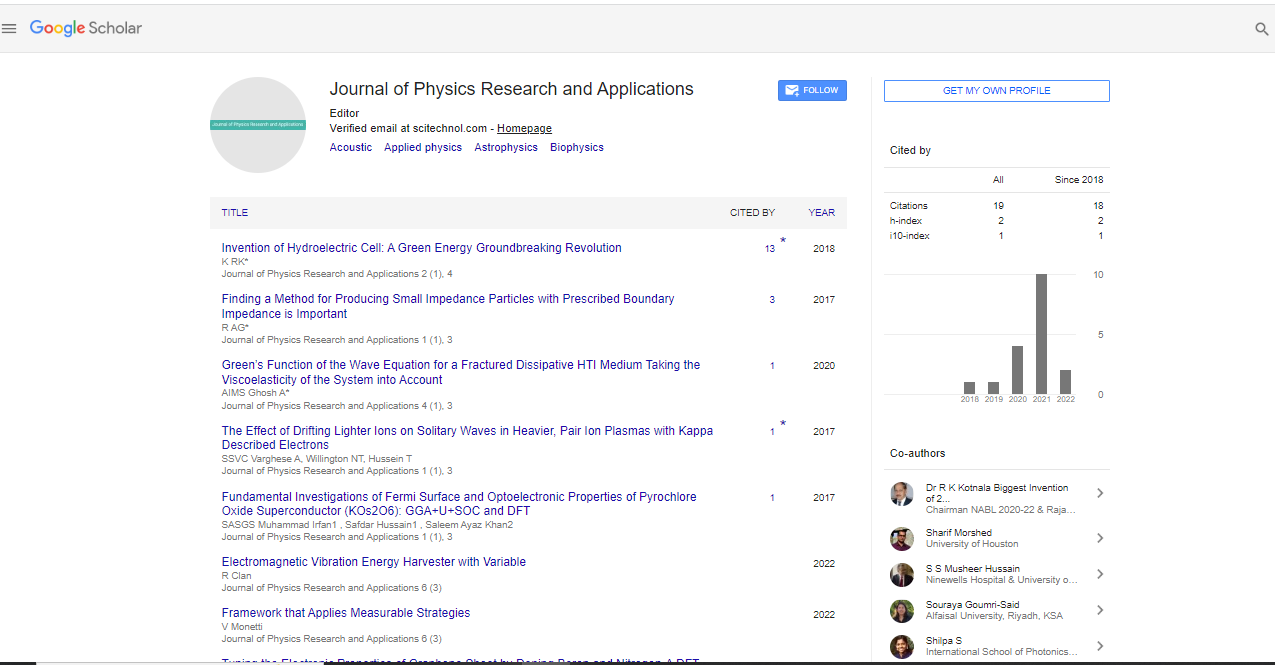Opinion Article, J Phys Res Appl Vol: 8 Issue: 2
Gravitational Wave Astronomy: Insights from the LIGO and Virgo
Yoshiro Moto*
1Department of Physics, Kyoto University, Kyoto City, Japan
*Corresponding Author: Yoshiro Moto,
Department of Physics, Kyoto University,
Kyoto City, Japan
E-mail: Yoshi@kyt.jp
Received date: 21 May, 2024, Manuscript No. JPRA-24-140080;
Editor assigned date: 23 May, 2024, PreQC No. JPRA-24-140080 (PQ);
Reviewed date: 07 June, 2024, QC No. JPRA-24-140080;
Revised date: 14 June, 2024, Manuscript No. JPRA-24-140080 (R);
Published date: 21 June, 2024 DOI: 10.4172/JPRA.1000109.
Citation: Moto Y (2024) Gravitational Wave Astronomy: Insights from the LIGO and Virgo. J Phys Res Appl 8:2.
Description
Gravitational wave astronomy has emerged as a revolutionary field, providing profound insights into the universe's most violent and enigmatic phenomena. This new era of astronomy began with the first direct detection of gravitational waves by the Laser Interferometer Gravitational-Wave Observatory (LIGO) in 2015. Since then, ongoing observations by LIGO, in collaboration with the Virgo interferometer, have unveiled a wealth of discoveries, significantly advancing our understanding of black holes, neutron stars, and the fundamental nature of gravity.
Gravitational waves are ripples in spacetime caused by accelerated masses, as predicted. These waves propagate at speed of light, carrying information about their cataclysmic origins. Unlike electromagnetic waves, gravitational waves are not easily absorbed or scattered by matter, allowing them to travel unimpeded across the universe. This characteristic makes them unique messengers that can reveal phenomena otherwise hidden from traditional telescopes.
The first detection of gravitational waves, designated, originated from t he merger of two stellar mass black holes about 1.3 billion light-years away. This landmark event not only confirmed the existence of gravitational waves but also provided the first direct evidence of black hole binaries. Subsequent detections have expanded our understanding of black hole demographics, revealing a diverse population with the varying masses and spins. The observation of kilonova, an explosive optical transient resulting from the merger, provided direct evidence of heavy element synthesis, such as gold and platinum, through the Rapid neutron capture process.
This discovery has profound implications for nuclear physics and our understanding of the origin of elements in the universe. The sensitivity of LIGO and Virgo has steadily improved through technological advancements, increasing the range and frequency of detections. Upgrades such as advanced laser systems, improved mirror coatings, and more effective seismic isolation have enhanced the interferometers' ability to detect weaker and more distant sources of gravitational waves. These improvements have led to the discovery of dozens of binary black hole mergers and several neutron star mergers.
Machine learning and sophisticated data analysis techniques have also played a important role in gravitational wave astronomy. These tools enable the rapid identification and characterization of gravitational wave signals amidst background noise, allowing for realtime alerts and coordinated follow-up observations with electromagnetic telescopes. This synergy between gravitational wave observatories and traditional astronomical instruments is vital for maximizing the scientific return from each detection.
Gravitational wave observations have opened new avenues for exploring fundamental physics and cosmology. For instance, precise measurements of the properties of black hole mergers provide stringent tests of general relativity in the strong-field regime, where deviations from Einstein's theory might be detectable. So far, all observations are consistent with general relativity, but future detections may reveal new physics. Additionally, gravitational wave astronomy offers a novel method for measuring the expansion rate of the universe, known as the Hubble constant.
The distance to a gravitational wave source can be determined from the waveform's amplitude, while the redshift can be obtained from associated electromagnetic counterparts. This independent measurement is important for resolving the current tension between different estimates of the Hubble constant derived from the cosmic microwave background and local distance ladder observations. Gravitational wave astronomy, by the pioneering efforts of LIGO and Virgo, has profoundly transformed understanding of the universe. The detection of gravitational waves has confirmed key predictions of general relativity, unveiled new populations of astrophysical objects, and opened a new era of multi-messenger astronomy.
 Spanish
Spanish  Chinese
Chinese  Russian
Russian  German
German  French
French  Japanese
Japanese  Portuguese
Portuguese  Hindi
Hindi 
